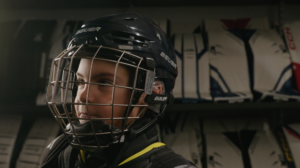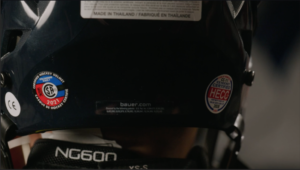August 16, 2023
Hockey Help: Everything you need to know about Helmets.
So, you’re ready to take your first steps onto the ice and conquer the world of hockey, huh? Well, before you start scoring those dazzling goals, there’s one thing you’ve got to get straight: helmets.
Yeah, those sleek, dome-like accessories are more than just a fashion statement – they’re your ultimate ice armour! Let’s dive into the world of hockey helmets and find out why they’re the coolest must-haves on the rink. Most leagues and rinks will mandate one, but why? Are helmets really all that important?
Short answer, is yes. Helmets are required to keep you secure and protected from anything unexpected that can happen on the ice. Whether it be bumping into other players or taking a tumble on the ice, wearing a helmet is crucial in keeping you safe.
How should my helmet fit?
Making sure that your helmet fits you properly is key. After all, the helmet that fits you properly is the one that will give you the best protection.
Here are some things to consider when you are trying on a helmet:
• Make sure the Helmet is nice and snug
• No space along the temples
• Should sit halfway down your forehead (one finger above eyebrow)
• Ears should be covered
• Helmet shouldn’t dig into your neck when you move

You will want some extra facial protection, but it’s important to know that only players who are 18+ are allowed to wear a half visor, and anyone younger will need a full cage or face shield. It’s up to the player which one they would prefer. Some people think having metal bars is annoying and can obstruct their vision, and some people might want to have a full face shield; but do note that these might fog up.
The most important thing to have in a helmet, is a snug chin cup, as this will prevent your helmet from sliding around and keep it secure on your head.
How long will my helmet last me?
The key to having a helmet last you, is taking proper care of it and finding one that fits right. Some helmets can be adjustable, so as you grow, you can expand the helmet as well.
Like all your equipment you will want to keep it dry. After being on the ice for a long period of time, make sure that you wipe it down and hang it up with the rest of your equipment when you get home. Don’t forget to check the padding inside your helmet when you are doing this as well. If any of the foam is getting firm or is falling out, this is your sign to replace it.
It’s a good idea during this time to check for any loose screws. If there is any, screw them in snug and tight, but make sure you don’t accidentally crack the shell.
What makes my helmet safe?
Any helmet that you buy needs to have the following 2 certification stickers in order to be worn on the ice:
• CSA- Canadian Standards Association; the year the helmet in that style and colour was certified
• HECC- Hockey Equipment Certification (USA’s helmet certification); the expiry date (only applicable in the United States)

Always look for these two stickers when purchasing a helmet, and make sure that they don’t fall off as you continue to use your helmet.
Do I need a mouth guard?
Whether or not you need a mouth guard really depends on the certain individual. Kids who have teeth still growing in may not have the biggest need for one. However; once those teeth are finally in then it is a good idea to get one.
Mouth guards are meant to help absorb impact, and can certainly save you some money at the dentist. They are also designed to be able to mould around your mouth to provide better protection and more comfort.
How much will this cost me?
Helmets for youth without a cage will cost you between $60 to $80. An adult helmet with or without a cage can go anywhere from $80 to $200 depending on the style and brand.
A mouth guard, if you chose to get one, will cost anywhere from $10 to $25. Think of it as an investment in your icy adventure – safety and style, all wrapped up in one sweet package.
So, congrats, you’ve just graduated from Helmet 101! Armed with the knowledge of a hockey helmet superhero, you’re all set to glide onto the ice with confidence, knowing that your trusty helmet has got your back – and your head!
Buckle up that chin cup, grab your stick, and show that rink who’s boss.

